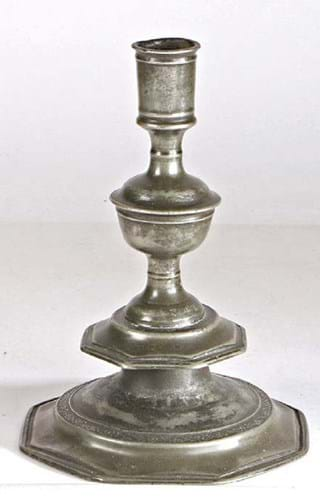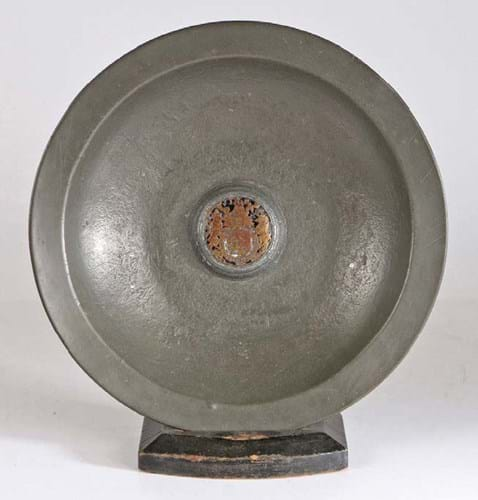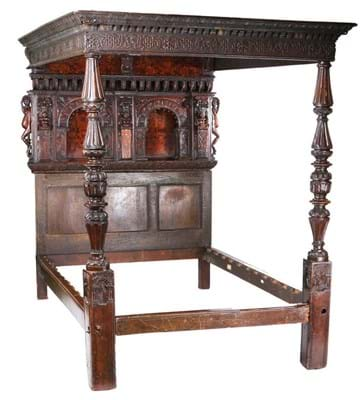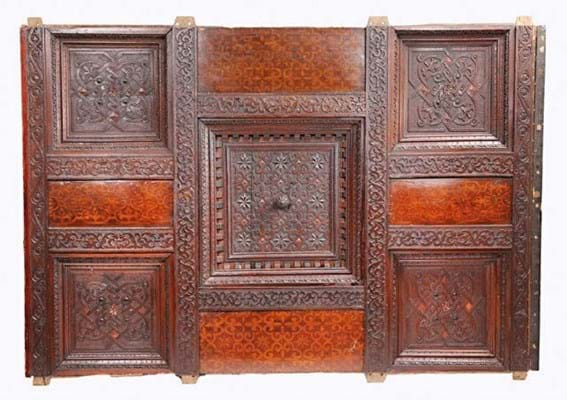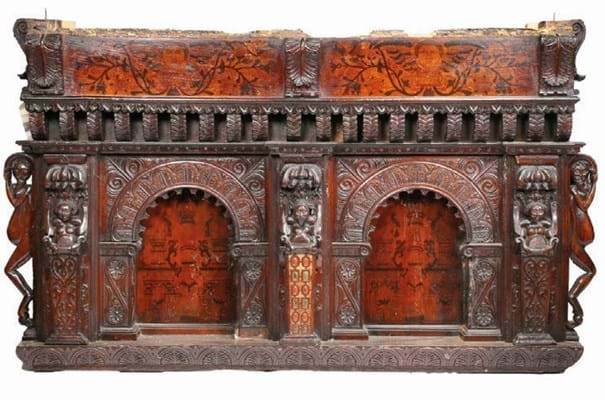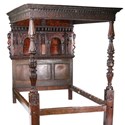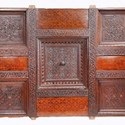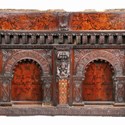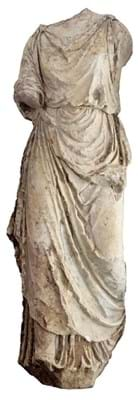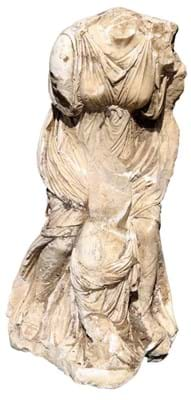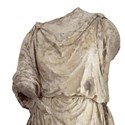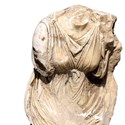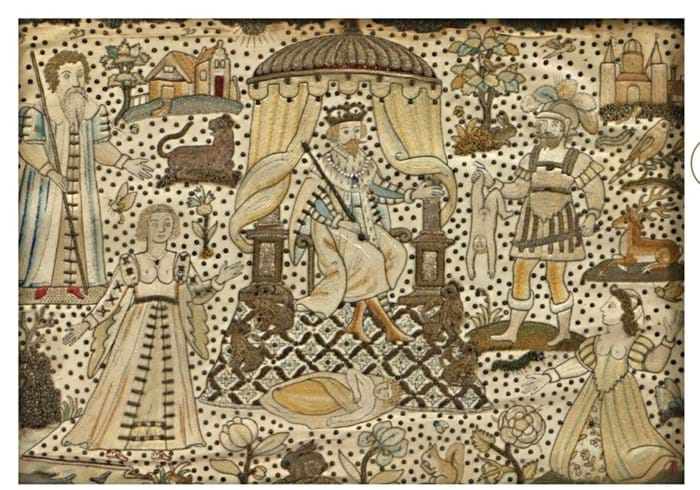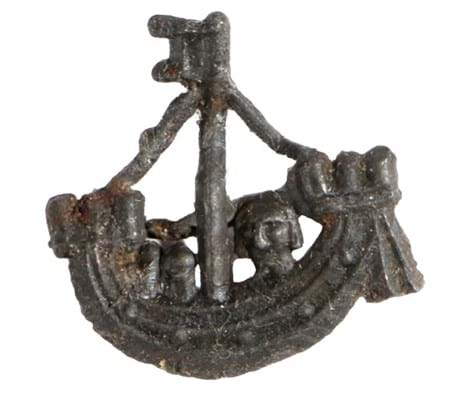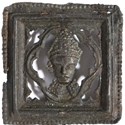As the sale title implies, period oak and vernacular furniture was a key part of Bishop & Miller’s (25% buyer’s premium) October 18 Oak Interior auction.
But this Stowmarket auction of over 700 lots also featured a wealth of other categories of antiques and decorative art, not least over 250 lots of metalware which formed the opening section.
Around 100 of them comprised a further selection of pieces from the pewter collection of Tony Chapman (1943-2022), a former president of The Pewter Society, the first part of which was offered in the same rooms in April this year (see ATG No 2592).
Chapman studied medicine at Christ’s College, Cambridge, working at Manchester royal Infirmary, and becoming registrar. In 1986, by then an orthopaedic consultant, he moved with his wife and two sons to Halifax and in the same year joined The Pewter Society.
Before long a large room in the 18th century former textile merchant’s home was given over to creating a secret pewter room hidden from view by a hanging oak corner cupboard attached to an invisible door. In this room Chapman filled every surface of its 17th century oak furniture and bespoke floor-to ceiling shelves with fine and rare British pewter.
His purchases included rare examples from other well-known collections such as that of David Little (sold by Christie’s in 2007), Christopher Peal and RF Michaelis.
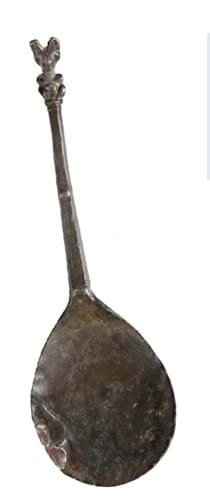
As well as bigger pieces such as candlesticks, tankards, measures and plates, there were examples of cutlery among the items from the Chapman collection. This rare English latten spoon from c.1450 featuring a knop shaped as a horned headdress and a flattened hexagonal-section tapering stem with an unusual mid ‘fillet’, proved to be one of the more sought-after examples, selling for a double estimate £1500 at Bishop & Miller.
Pick of the pewter
Pewter highlights from this second instalment of the Chapman collection included a Charles II period candlestick and a James I period pewter and enamel rosewater bowl, which realised prices of £9800 and £7000 respectively against guides of £10,000-15,000 and £8000-12,000.
The candlestick, which was dated to c.1675 and stood 10in (25cm) high, was set on an octagonal base decorated with vine motifs and featured a baluster knop stem and a domed octagonal drip tray. A piece which was illustrated in J Gadd’s Pewter Candlesticks, it had a provenance to a Sotheby’s auction in June 1997.
The rosewater bowl, which measured 12in (32cm) in diameter, had a plain rim (with a possible touchmark) and a deep booge (the curved wall between well and rim) centred by a raised circular moulding inset with a brass boss enamelled in red, white and blue with the Royal Arms of England and James VI of Scotland plus the cypher IR and the Garter. It was catalogued as English or Scottish but probably London, c.1605. It had a provenance to the AC Wall collection c.1935 then by descent until sold at Christie’s in 1998.
As the Bishop & Miller catalogue noted, the authenticity of some enamelled boss dishes has been questioned. Doubts over originality have principally applied to ‘stepped’ booge examples, but concerns have rarely been conclusive. The enamelled bosses were made as independent medallions and soldered on to dishes. It is therefore relatively easy to conjecture whether this was done at the time of the dishes’ manufacture or at a later date.
There was also a second English or Scottish enamelled rosewater bowl of the same size with the same provenance but enamelled with the arms and cypher of Charles I, so later in date, c.1640. It made £4500 against a £5000-8000 guide.
Oak highlights
When it came to the oak furniture, the sale contained a particularly attractive example of an oak tester bed dated to the Elizabethan era, c.1570 and later, that boasted a wealth of carved decoration.
The tester and headboard were both elaborately and attractively carved and decorated. The tester featured a recessed panel carved with eight pointed stars and fleur de lys flanked by sycamore panels that had similar decoration in penwork plus corner panels carved with a knot pattern.
The headboard had two Nonsuch panels set within a carved arcade flanked by figural terms surmounted by a sycamore panel that was decorated in red and black stained penwork with angel masks, Tudor roses, hops, carnations and strawberries. The bed also had typical end posts centred by a cup and cover and measured 5ft 7in (1.7m wide) x 7ft (2.14m) high. Offered with a set of custom-made bed hangings, it sold within estimate at £10,500.
Another early piece of oak among the top-selling lots was The Wolseley Hall Overmantel, a rare Elizabeth I carved oak overmantel measuring 5ft 8in (1.74m) wide that was dated to c.1580, with a family armorial and royal cypher CR added c.1630.
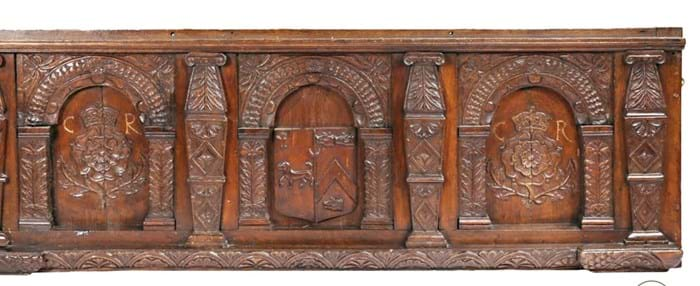
Elizabethan oak overmantel decorated c.1630 with the arms of Sir Robert Wolseley and his wife Mary Wroughton, £4500 at Bishop & Miller.
It was composed of three arched panels divided by ionic pilasters, the outer ones carved with a Tudor rose and the CR cypher while the centre panel had the arms of Wolseley and Wroughton that are thought to commemorate the marriage of Sir Robert Wolseley (1587-1646) and Mary Wroughton (1605/7-1671). They married c.1630, shortly after Robert was created a baronet on November 24, 1628.
Prior to this date Robert acquired the family estate of Wolseley from a distant cousin, Sir Thomas Wolseley. The estate was held by the Wolseley family from the 11th century and the overmantel was presumably once in situ in the Manor House of Wolseley Hall, Colwich, Staffordshire. Robert Wolseley was a staunch Royalist and it would stand to reason that he added the royal cypher along with his own coat of arms to an existing Elizabethan overmantel in the hall.
Offered with an estimate of £2000-3000, it sold for £4500.
Body beautiful
The highest price of the auction came from neither the metalwork nor the oak. It was something of a sleeper from the sculpture element of the sale which contained two lifesize marble female figures, both classically draped, and measuring 4ft 6in (1.4m) in height that were consigned by a local school.
Both figures lacked a head or arms and each was catalogued simply as an 18th century marble figure, modelled as a lady wearing a flowing robe, with estimates of just £400-600 apiece.
They attracted keen attention and bidding, however. The first was particularly in demand, with bidding going to £37,000, while the second figure, which also featured a child standing at her feet, was taken to £5200. They were secured by different UK buyers.
Another of the top-priced lots, one making £13,000, much more than the £1000-1500 predicted, was an example of a mid-17th century English silkwork embroidery.
The framed and glazed panel measuring 16 x 21in (41 x 53.5cm) had typical features of needlework pictures from this period. It depicted a biblical subject - the Judgment of Solomon showing the king settling a dispute between two women over the parentage of a baby - surrounded by spot motifs of flowers, insects, birds and animals, worked in coloured silks and metal thread set against a silk ground applied with spangles.
The picture also bore a label to the reverse referring to the needlework as being bought in 1721 at Ms Thursby’s sale Nr Northampton.
Pilgrim badges
Pilgrim badges were small souvenirs worn by those who had undertaken a pilgrimage to a holy site. Usually made from a base metal, their production was at its height during the 14th and 15th centuries.
Probably the most famous place to make a pilgrimage in England at the time was the shrine of St Thomas Becket in Canterbury Cathedral, an event immortalised in Chaucer’s Canterbury Tales.
The pewter and metalware section of Bishop & Miller’s auction opened with a group of five modestly guided lots of 14th century pewter pilgrim badges from the Chapman collection all relating to Becket.
The most expensive at £700 apiece were this 1¼in (3.2cm) square badge of c.1350 with a mitred bust of the saint set within a trefoil spandrelled quatrefoil and a 1 x 1in (2.5 x 2.5cm) badge c.1350-1400 fashioned as a clinker-built boat with a saint in the centre that probably depicts Becket returning from exile in France in December 1170.
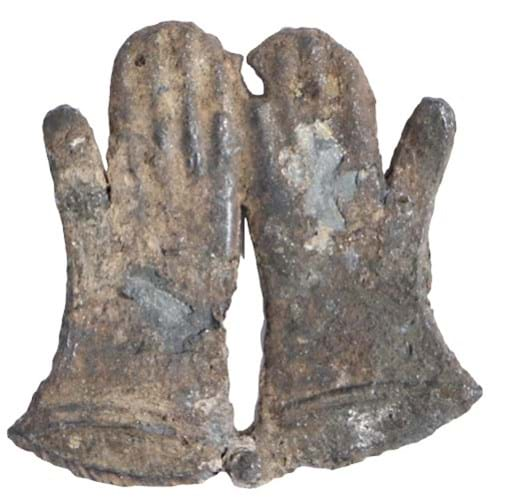
A Pilgrim badge formed as a pair of St Thomas Becket's gauntlet-like gloves linked at the cuff, £240 at Bishop & Miller.
The 1in (2.5cm) badge formed as a pair of Becket’s gauntlet-like gloves linked at the cuff, sold for £240. Examples comparable to the gloves and the ship can be found in the Museum of London collection.


